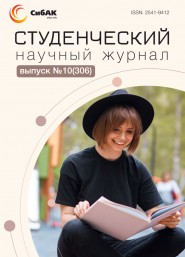Статья опубликована в рамках: Научного журнала «Студенческий» № 10(306)
Рубрика журнала: Педагогика
Скачать книгу(-и): скачать журнал часть 1, скачать журнал часть 2, скачать журнал часть 3, скачать журнал часть 4, скачать журнал часть 5
FORMATION OF READING LITERACY OF YOUNGER SCHOOLCHILDREN THROUGH THE USE OF SEMANTIC READING TECHNIQUES
ФОРМИРОВАНИЕ ЧИТАТЕЛЬСКОЙ ГРАМОТНОСТИ МЛАДШИХ ШКОЛЬНИКОВ ЧЕРЕЗ ИСПОЛЬЗОВАНИЕ ПРИЕМОВ СМЫСЛОВОГО ЧТЕНИЯ
Дорохова Анна Игоревна
Белгородский государственный национальный исследовательский университет» (НИУ «БелГУ»),
РФ, г. Белгород
Богачев Роман Евгеньевич
научный руководитель, канд. фил. наук, доц., Белгородский государственный национальный исследовательский университет» (НИУ «БелГУ»),
РФ, г. Белгород
ABSTRACT
The article discusses current issues of the formation of reading literacy among younger schoolchildren, which is a key competence for successful learning and socialization. Special attention is paid to the use of semantic reading techniques as an effective tool for developing understanding of the text, critical thinking and reader interest. Specific examples of semantic reading techniques such as "Reading with stops", "Questions to the text", "Clustering" and "Critical Thinking technology" are analyzed. Their practical application in elementary school lessons is demonstrated. Methodological recommendations for primary school teachers on the implementation of semantic reading techniques in the educational process are proposed.
АННОТАЦИЯ
В статье рассматриваются актуальные вопросы формирования читательской грамотности у младших школьников, являющейся ключевой компетенцией для успешного обучения и социализации. Особое внимание уделяется использованию приемов смыслового чтения как эффективного инструмента для развития понимания текста, критического мышления и читательского интереса. Анализируются конкретные примеры приемов смыслового чтения, таких как "Чтение с остановками", "Вопросы к тексту", "Составление кластера" и "Технология критического мышления". Демонстрируется их практическое применение на уроках в начальной школе. Предлагаются методические рекомендации для учителей начальных классов по внедрению приемов смыслового чтения в образовательный процесс.
Keywords: primary school, elementary school students, reading literacy, semantic reading, semantic reading techniques, critical thinking, text comprehension, teaching methods.
Ключевые слова: начальная школа, младшие школьники, читательская грамотность, смысловое чтение, приемы смыслового чтения, критическое мышление, понимание текста, методика преподавания.
In the modern world, characterized by a huge flow of information, reading literacy is of particular importance. The ability to understand, analyze and evaluate what has been read is a prerequisite for successful learning, professional activity and social adaptation. In primary schools, as the foundation of all education, the formation of reading literacy is one of the priorities.
Semantic reading is a type of reading, the purpose of which is the most accurate and complete understanding of the information contained in the text. It involves the reader's active interaction with the text, its analysis, critical reflection and evaluation. Semantic reading techniques allow you to develop attention to detail, logical thinking, imagination and other important skills necessary for the formation of reading literacy.
Examples of semantic reading techniques:
"Reading with stops": This technique involves reading the text in small fragments followed by a discussion of what has been read. The teacher asks questions that encourage students to analyze the content, predict future events, and express their opinions.
"Questions to the text": Students independently or with the help of a teacher formulate questions to the text, answering which they understand its content more deeply. There are different types of questions: factual, interpretative, evaluative, and creative.
"Making a cluster": A cluster is a graphical organization of information that makes it possible to visualize the relationship between concepts and ideas contained in a text. Creating a cluster helps students structure information, highlight key ideas, and see the text as a whole.
"Technology of critical thinking": This technology offers a wide range of techniques aimed at developing the ability to analyze information, evaluate its reliability and formulate their own conclusions. These include "Reading with notes", "Thick and thin questions", "Cinquain", etc.
Semantic reading techniques can be used in reading lessons, the Russian language, the surrounding world, and other subjects. It is important that the application of these techniques is systematic and purposeful.
References:
- Bordovskaya, N.V. Psychology and pedagogy: textbook / N. V. Bordovskaya, S. I. Rozum. - St. Petersburg: Peter, 2018. 320 p.
- Golovanova, N.F. Pedagogy: textbook / N.F. Golovanova. Moscow: Academia, 2019. 352 p.


Оставить комментарий